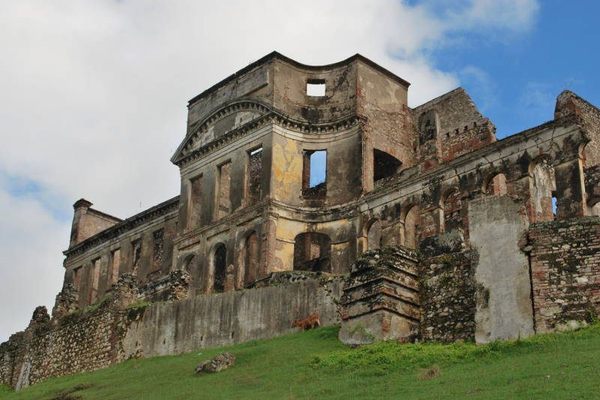NYC’s Possible Pompeii Columns That Link Its Great Fire to Ancient Volcanic Doom
Delmonico’s on Beaver St. in Manhattan (photograph by Allison Meier/Atlas Obscura)
Are relics from Pompeii — that Roman city wrecked by Mount Vesuvius in 79 AD — embedded in the façade of one of New York City’s most iconic restaurants? The answer is a wavering “maybe,” but the symbolism of the two marble columns framing the entrance to Delmonico’s resonates both with that ancient destruction, and one of New York’s greatest disasters.
I had never heard the story that the two corinthian columns bookending the gold Delmonico’s name at 56 Beaver Street were from Pompeii until this past Sunday’s historic Lower Manhattan tour from Dan Veksler of Other World Tours for the Obscura Society. Veksler was careful to state that “by all accounts” the columns were from Pompeii, meaning the proof is vague, but as I touched the obviously old stone and looked at the detailed capitals, I wondered how much was true.
Delmonico’s on Beaver St. in 1893 (via British Library)
The history of Delmonico’s, while far from the grandeur of Pompeii, is a significant one for the dining culture of Manhattan. Started as a pastry shop in 1831 by two Swiss brothers, it eventually expanded into several restaurants. Its culinary breakthroughs included having the first tablecloths in Manhattan, the first printed menus, the first private seating, and being the first to invite women to dine alone without judgement on their character. As such a successful and stately enterprise, Delmonico’s built lavish dining halls, not least the one that opened in 1891 on Beaver Street. Designed by James Brown Lord in a Renaissance Revival style, it wedges into a triangle of land with orange terracotta and brick, along with those two curious columns lodged in the doorway, clashing with the earthy colors.
The columns had already been installed on the Delmonico’s on Williams Street, destroyed in the Great Fire of 1835. The fire consumed 17 blocks of the city, which was still mostly just the lower tip of Manhattan, and was a big reason buildings were rebuilt in the hardier brick. The Pompeii columns were hauled from the ashes, a predicament perhaps not unfamiliar to them, and incorporated into the new Delmonico’s.
The columns at Delmonico’s today (photograph by Allison Meier/Atlas Obscura)
Now, as to the veracity of their origin, it’s fuzzy. Most reports, such as the Landmarks Preservation Commission’s, are careful to say something along the lines that the columns “were reputed to be from the doorway of a villa in Pompeii.” However, more exuberant and perhaps less trustworthy sources like Valentine’s Manual of the City of New York: 1917-1918 crow: ”Through this portico passed no doubt many of the stately figures of Pompeii, its distinguished public characters, its merchant princes, its wealthy social leaders and hosts of gay youths and merry maidens intent on pleasure just like the youths and maidens of our own pleasure loving city today.”
Romantic, sure, but I couldn’t find a definitive answer. However, having a priceless ancient artifact out in the open like this, unmarked and available to the touch, isn’t as unusual as you might think. Just outside of New York City in Yonkers at the Untermyer Gardens are two 23-foot ancient Roman columns that have been adorning the 1920s park for decades without fanfare. Either way, there’s a bold phoenix-like symbolism with the Delmonico’s columns, where after the city was almost totally destroyed by a fire, they resurrected their own institution by iconizing a proclaimed artifact of another city lost to a fiery doom.
A column at Pompeii (photograph by Xavi/Flickr user)
Thanks to Dan Veksler of Other World Tours for introducing us to this New York curiosity. To discover more of the city’s history with us, join the Obscura Society for a tour or other adventure.




















Follow us on Twitter to get the latest on the world's hidden wonders.
Like us on Facebook to get the latest on the world's hidden wonders.
Follow us on Twitter Like us on Facebook